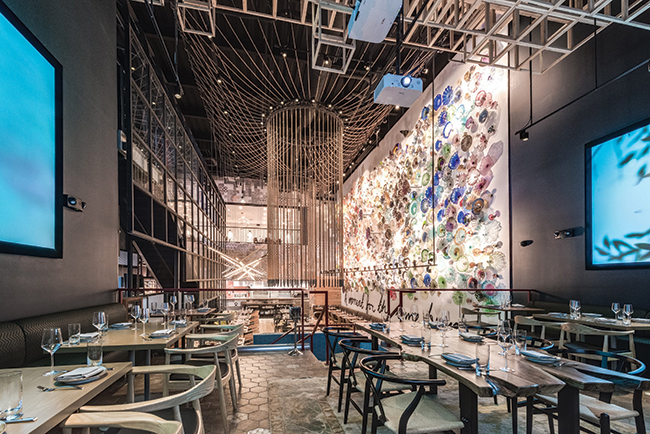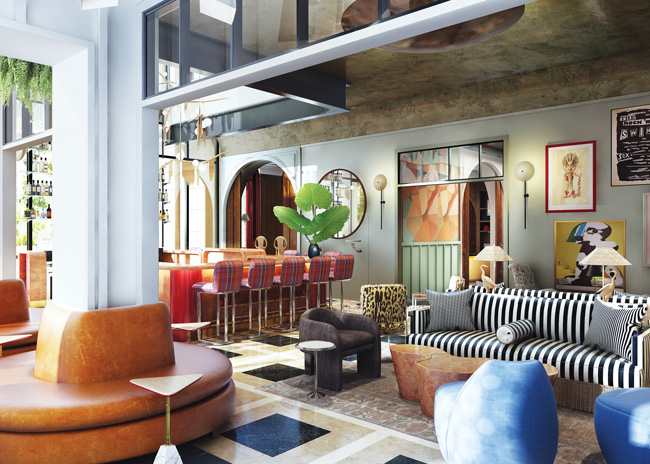Overlooking the acoustics management during the design phase can not only hamper the guest experience it can lead to costly updates later.
Regardless of dining style the sounds in many restaurants are higher than conversational noise levels, making it difficult for patrons to speak without extra effort or to hear their dining companions without straining. Indeed, surveys repeatedly confirm patron's dissatisfaction with noisy dining rooms. A Consumer Reports survey of 47,565 readers reported on 110,517 meal experiences in 102 different table-service chain restaurants. The readers complained about the noise level in one out of four meal experiences.
A Zagat Survey recently researched 15,000 restaurants and found that noise level was the second most common complaint behind service. However, younger patrons tend to enjoy loud and lively eating environments. So, how can a restaurant's design control the noise level so that it comes in right below the conversational sound level while keeping the environment lively and exciting? Many restaurateurs definitely have their pulse on the answer to this enigma; the solution relies on acoustical engineering.
A Sound Management Approach
Acoustics may arguably be the most technically difficult architectural system to design but it's an element of restaurant design that should be considered at the start of any building or remodeling project. Trained acoustical engineers can help.
"An acoustical engineer makes determinations and recommendations based on the sizes and shapes of the spaces, the types of finish materials, the function of the space, the degree to which the space's noise may fluctuate with different activities and the owner's intent," says Lisa Schott, president and principal acoustical consultant at Quietly Making Noise, LLC, and a member of the National Council of Acoustical Consultants.
Noise levels at nightclub-type dining venues, for instance, typically rank among the highest across all types of restaurants. Employees who complain about ringing ears, headaches and scratchy throats after a work shift may suffer hearing loss in this type of environment. Many times owners simply encourage their employees to use ear plugs, but restaurant operators can employ tangible architectural solutions to better manage the audio levels without compromising the owner's desired sound and music effects.
Certainly, sound pollution — or unwanted noise — so loud it can contribute to hearing loss is something restaurant operators must take seriously. Not only can it alienate customers and impact revenues, it can also affect employees' health. The Occupational Safety and Health Administration (OSHA) monitors sound levels in work places in an effort to protect workers from permanent hearing loss. OSHA standards for sound include a maximum limit of sound exposure at a certain level per a length of time: 90 decibels for up to 8 hours per day; 95 decibels for 4 hours per day; 100 decibels for 2 hours per day, etc.
The owners of Toronto's Real Sports Bar & Grill hired an acoustics engineer to test the restaurant's sound levels, according to a recent report titled "When Dinner is Deafening," by Susan Pigg for the Toronto Star's website thestar.com. Not surprisingly, they found extremely high noise levels during popular games when the sports bar was crowded. During peak "cheering times," decibel levels reached dangerous levels. To help remedy the problem, the owner decided to install acoustical materials to dampen the noise so that table conversations could carry on through cheering noise. Among the steps he took was to cover many of the walls in sound-absorbing panels and tuck mounds of noise-capturing insulation made from recycled jeans behind upholstered black ceilings.
The acoustical improvements have made the restaurant more popular, according to the report. Nonetheless, the owners could likely have avoided what turned into a $200,000 improvement project had acoustics been part of the building's original design plan.
In the same article, Pigg listed decibel levels recorded using a simple iPhone app at a number of local restaurants to illustrate the extent of the problem. While Schott says such amateur devices don't sufficiently determine sound levels and can be off by as much as 10 decibels due to poor microphone quality, the fact that they're being used as such to call out noisy restaurants should be eye-opening.
If complaints are coming in — or if a restaurant plans new builds or retrofits — it's a good idea to call in an expert to accurately analyze the sound levels throughout the facility. Relying on an iPhone app may give an indication of a noise problem, but a professional assessment can more accurately determine where to best make the investments in acoustics design.
Design for Maximum Occupancy
Just as with furniture selection and layout, when considering restaurant acoustics it's important to keep a packed house scenario in mind — i.e., what are the noise implications the restaurant or individual spaces within it reach during maximum occupancy? Decibel levels that may be comfortable and acceptable on a Tuesday or Wednesday night rise to unbearable levels for many guests on a busy Saturday night or during special parties or events. "Some of our restaurateur clients come to us requesting a restaurant design that has specific acoustical goals," says Jim LaPiana, vice president and director of design for The Evans Group, an Orlando-based architecture firm. One specific example of a client that had such goals included in the bid documents was a new country club. The operation included a few different dining areas though all required an environment in which club members could carry on quiet conversations during meals. Board members were particularly concerned that a large banquet room be conducive to conversations regardless of how many people were in the space or how large it was after moveable partitions were set up or removed.
"What is so interesting about country club dining spaces is that the number of people in each space can vary greatly. The acoustics design had to accommodate several different scenarios," LaPiana notes. After the building was constructed, noise levels during a large social event reached unacceptable levels. Schott, who worked with LaPiana from the design's inception, came back to the club to test the noise levels so final adjustments could be made. Acoustical panels were added to help bring the sound levels down to an acceptable level during maximum occupancy occasions.
To be sure, noise control strategies used in restaurants vary greatly and should be appropriate to both the brand and to its target demographic. Many are loud and high energy by design. Other restaurateurs pay more than double the cost for acoustical treatments as a retrofit project. Still others budget for the acoustical engineer to specifically design the spatial effects the owner wishes to achieve.
"The noise level in a restaurant needs to come in right under the one-on-one conversational level. Sometimes high ceilings with a coiffure finish solve the majority of any sound issues. But many times sound issues are much more complex," says Clark Wolf, president of Clark Wolf Company, a New York-based food and restaurant consulting firm.
Many architectural factors play into the restaurant's noise control strategies. "Both the vertical and the horizontal planning affects the sound transmittance and reverberations throughout the space," adds Schott. The spacing of the tables and the seating designs represent critical factors in controlling the sound. High-backed booths allow patrons to enjoy a conversation at normal speaking levels while listening to background music that drowns their conversation out before it reaches the next table.
Music, of course, can contribute mightily to creating atmosphere and, often, noise pollution within a restaurant. The music type, beat, level of intensity and volume all have one type of effect or another. "The music design is important for contemporary restaurants. Exact selections proceed throughout the evening, starting with quicker paced, more upbeat music at the beginning of the night and ending with slower music," says Wolf. While reports vary slightly, most agree that good sound design and strategic use of music can lead to greater revenues.
Consider Kitchen, Outdoor Noise Sources
While most restaurant noise pollution comes from music and the patrons themselves — obvious considerations when thinking specifically of designing dining spaces for acoustics — don't overlook other noise sources. "There are times when it is the kitchen and the cooking hoods that are the noise culprits," explains Schott. In one instance, Schott was taking dining room noise readings when the restaurant's open-kitchen hood started up and transmitted a loud, low frequency sound throughout the restaurant. "When the hood kicked on, the voices got louder and the music was turned up. The effect of noise building upon noise was remarkable," she says.
Many of the retrofit acoustical projects that Schott handles also relate to outdoor noise, which may not impact customers but does impact the restaurant's neighbors. She says it's hard to predict how the surrounding community will be affected by a restaurant's design in terms of the noise it generates but if considerations are put into place from the beginning, then alterations later are natural and fairly easy to engender. Restaurants can solve outdoor sound issues by setting up wall screens and by installing smaller and more plentiful speakers set at a lower volume.
Acoustics Design and Materials
In laymen's terms, acoustics design is the study of how sound transmits through a space and through materials. "Each material has its own reverberation properties. Likewise, each unique space will encourage sound to travel throughout at differing magnitudes," says Schott. Indeed, acoustical design is complex and always involves a little bit of experimentation.
Contemporary architectural trends and modern restaurant designs often include harder surfaces such as tile, glass, concrete and metals that sound bounces off of versus more traditional materials that inherently have greater sound-absorption qualities. Likewise, open kitchen designs and outdoor seating present more challenging acoustical situations for restaurant owners.
"An acoustical engineer is usually a member of the building design team much in the same way as a structural engineer or a mechanical engineer," says Schott. After the acoustics engineer receives a schematic plan, the engineer evaluates the space against the sound level intent, analyzing how noise will transmit and reverberate throughout. The engineer then offers suggestions to the interior designers and architects on how to make design changes to meet the sound level intent. At times, it's something as simple as adding a certain amount of square feet of absorptive material to the space.
Such acoustical materials are no longer ugly and awkward, as many were in the past. One way to solve noise pollution problems is to place select materials in target locations. "The restaurant's design does not ever need to be compromised. Creative acoustical materials may include draperies hung from the ceiling and linen-wrapped baffles. The options are varied. Work the acoustics into the design from the beginning and there will not be a problem later," Wolf advises.
Among the many complex projects that Schott's acoustical design team has tackled was a wine-tasting restaurant built inside of a cave at a Napa Valley winery. "As one may imagine, the acoustics in a cave are not at all conducive to the type of environment the restaurant owners had hoped for their venue," says Schott. "Ultimately, an innovative type of plaster that was designed to absorb noise was applied to the real stone. You would be amazed at how real the plaster appears and at the same time how effectively the sound is controlled in the space."
While most restaurant spaces present fewer acoustical challenges than a wine cave might, finding the perfect mix of quiet and liveliness is nonetheless a moving target. Every space is unique and requires a different approach with various spatial dimensions, materials, furnishings and equipment used, noises from surrounding environments, music and, of course, the dynamic number of patrons. What's indisputable, however, is that acoustics demands attention. Says Wolf, "One thing is for sure, acoustical design is critical and it must be incorporated into the beginning design work."
Loud & Proud: Texas Roadhouse
One company for whom acoustics isn't a concern is Texas Roadhouse, recently awarded the distinction of being the loudest table-service restaurant chain among 101 others in a Consumer Reports survey. Its owners are "proud to be loud" and have since printed t-shirts for their waitstaff with this exclamation.
"We want people to come to our restaurant and escape. Each restaurant has a juke box that has more than 1,000 song selections and plays loudly when a patron makes a free selection. Line dancing and throwing peanut shells add to the atmosphere. We want our patrons to relax and enjoy themselves without worrying about what other people will think," says Travis Doster, director of public relations for the 380-unit Louisville-based chain.
While Consumer Reports' readers complained about Texas Roadhouse's noise levels, two-thirds of the chain's patrons come back twice per month, according to Doster. He notes that the owners did not specifically design the acoustics of the restaurants, but that their clientele seems happy and that they have not received direct complaints about the noise.
10 Factors that Affect Acoustical Design
- Sound frequencies
- Sound sources
- Volatility of noise in space
- Horizontal layout of space
- Ceiling height
- Volume of space
- Equipment in use within the space
- Outdoor sound issues
- Architectural materials
- Fabrics and finishes




